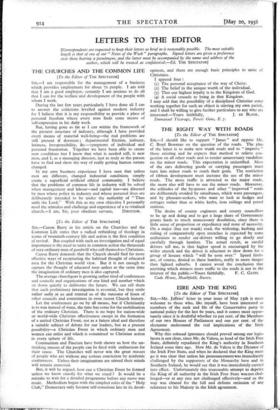THE RIGHT WAY WITH ROADS [To the Editor of THE
SPECTATOR] SIR,—I should like to support " Janus " and oppose Mr. C. Boyd Bowman on the question of the roads. The plan of the latter is to make new trunk roads and to " improve - those existing and he expects that method to relieve con- gestion on all other roads and to render unnecessary vandalism on the minor roads. This expectation is unjustified. Most of the cars delivering goods or carrying passengers must turn into minor roads to reach' their goals. The restriction of ribbon development must increase the use of the minor roads. The more traffic is attracted to the major roads, the more also will have to use the minor roads. Moreover, the solitudes of the by-passes and other " improved " roads are deliberately avoided by omnibuses, which want passengers, and by pleasure-seekers, who want to look at hedges and cottages rather than at white kerbs, iron railings and petrol stations.
The desire of county engineers and county councillors to be up and doing and to get a large share of Government grants leads to much unnecessary desolation, since there is little sense of proportion or expediency and none of necessity. On a major (but not trunk) road, the widening, kerbing and railing of comparatively open stretches is expected by, some enthusiasts to render car-drivers willing to go slowly and carefully through hamlets. The actual result, as candid drivers tell me, is that higher speed is encouraged by the wider stretch and the driver is reluctant to slow down for a group of houses which " will be soon over." Speed limits are, of course, denied to these hamlets, really in more "danger than lighted suburbs. I cannot avoid the conclusion that anything which attracts more traffic to the roads is not in the


















































 Previous page
Previous page